Cleveland Quarries: Bringing the Art of Stone Carving into the 21st Century
 Karin Kirk
Karin Kirk
usenaturalstone.com
Diagrams © Karin Kirk
Photos Supplied Courtesy Cleveland Quarries Company
It is not every day that sandstone makes national news. But when Cleveland’s baseball team changed its name to the Cleveland Guardians, the name prompted an outpouring of curiosity. What, exactly, are Cleveland’s guardians?
As many have since learned, the team’s new name refers to the Guardians of Transportation, which are eight massive statues that grace a bridge across the Cuyahoga River. The art-deco figures were completed in 1932, and they symbolize the spirit of progress in transportation.
The vicinity around Berea, Ohio, is known as “the Sandstone Center of the World,” and the guardian statues are but one of many examples of exquisite carvings made from Berea sandstone.
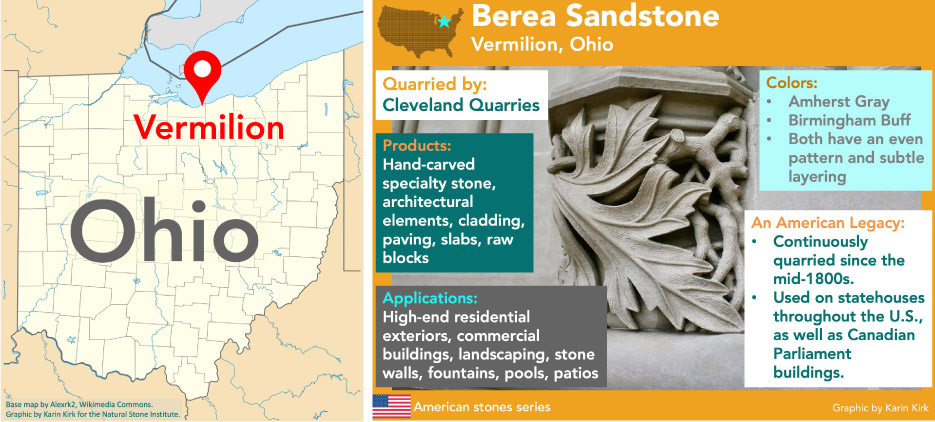
The Berea sandstone is famous for good reason; it’s a durable stone with few irregularities. It can yield large blocks with an even grain and consistent coloring, and it can be carved, sawn, or chiseled to suit nearly any taste. The sandstone straddles the all-important line of being hard enough to withstand the elements, yet soft enough to be workable.
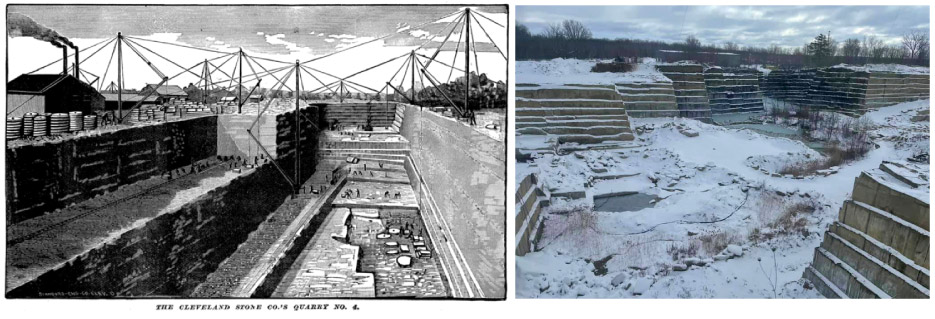 |
|
Abovee: Quarry Number 4 in its heyday (left), and now. |
Though the stone was first used to make grindstones, its abilities as building stone became readily apparent, and northern Ohio became a hotbed for quarries, stretching westward from Berea into Elyria and Amherst. Beginning in the mid-1800s, holes were sunk into the ground and became ever larger and deeper, as the extracted blocks found their way onto churches, courthouses, banks, and monuments, and the reach of the stone extended past Ohio and into Chicago, New York City, Canada, and beyond.
During the heyday of Berea quarrying, it was one of the largest industries in the state, and the Buckeye quarry reached a depth of 240 feet, said to be the deepest quarry of the time. The May, 1887 edition of The Manufacturer and Builder heralded the stone and, saying “the production and sale of this valuable material employ a small army of men.” Dozens of quarries and mills operated throughout the region. Eventually the smaller operations were bought up by larger ones, until two large companies had amassed most of the quarries. The Cleveland Stone Company was formed in 1886, and rival Ohio Quarries formed in 1903. In 1929, the Cleveland Stone Company bought out the Ohio Quarries, launching the Cleveland Quarries Company, which continues on today.
Though there are many fewer active quarries in the region, the tradition of quarrying and stone masonry has never stopped. The Cleveland Quarries is keenly aware of its deep history, but it’s also embracing innovation. The techniques, customers, and applications have all changed over the nearly 200-year history of the Berea sandstone. But the stone itself remains as dependable and useful as ever.
An Evolving Business Model
Dave Dunn, the Director of Sales at Cleveland Quarries, describes why Berea sandstone has remained desirable for so long. “It has a very tight matrix binding the minerals. It is very predictable. And, at the same time, it’s workable enough to make it easy to carve, yet hold fine details. And then, you combine that with the inherent strength and properties of the stone itself. It’s very desirable. Carvers like working with it.”
In one sense, Cleveland Quarries continues to do what it always has: quarry stone for use in paving, slabbing, and dimension stone. But Dunn explains that the company has “evolved quite drastically” in recent years. The combination of high-end residential clients and a focus on cutting-edge methods has ushered in a new chapter in the company’s long history.
Zach Carpenter, company President, reflects on the transition over the past decade. “We focused at the beginning on the very simple projects. We didn’t have the capacity to do a lot of the things we do now. And every year, we’ve added more to our capacity.” Carpenter points out that the company hasn’t abandoned its original focus. “We still do what we’ve always done — but we’re really pushing on the more complex because of the level of expertise we’ve gained.”
“We will always promote our stone,” says Carpenter, “but we also are really starting to promote our capabilities.”
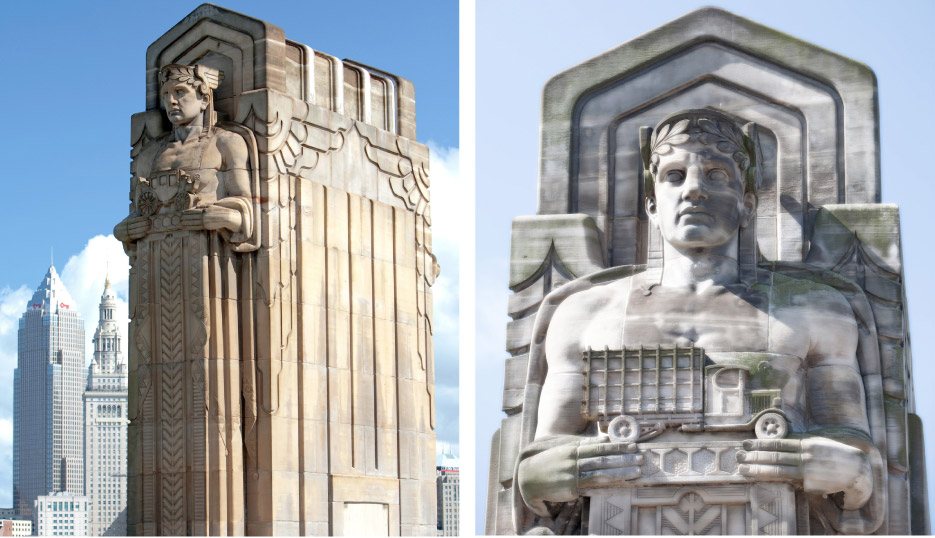 |
|
Above: Eight towering Berea sandstone Guardians of Transportation keep vigilant watch on Cleveland’s Hope Memorial Bridge. |
Carving Out a Niche
Cleveland Quarries went high-tech in 2013, when they purchased their first 5-axis CNC machine to carve stone. CNC stands for computer numerical control, and it’s an automated cutting tool that follows a programmed pattern while carving and shaping every side of the stone. A 5-axis machine costs about as much as a single-family home in the Vermilion area, and since 2013 the company has since added two more 5-axis machines. The combination of a reliable stone, skilled craftspeople, and computer power have made Cleveland Quarries a leader in a niche market. Carpenter expresses a sense of satisfaction: “We’ve taken on jobs that we simply never could have taken on before.”
The use of computerized tools has changed the flow of production. “Those machines run in the evenings when we’re not there,” says Carpenter, “so a lot of that work can be done by a single operator along with some labor to load up saws.” Carpenter explains that programming and operating the machines are high skill jobs, but “they’re less labor intensive than when we needed to do it all by hand.”
But hand-carving remains an essential part of the process. “We have several hand carvers and a couple artists here as well,” says Carpenter.
Dunn describes the balance between using computer power and skilled hand labor: “It’s a finely choreographed dance of how much work is done on the CNCs and how much is done by our hand carvers,” he says.
“These hand carvers are fully capable of taking a square piece of stone and turning it into a very organic carving,” says Dunn. “But it’s not always the best use of their time to bulk out and remove material when the saws could do that overnight.”
Dunn explains that the CNCs are best used to “bulk out” blocks of stone, beginning with a rough block and shaping it partway into the finished piece. Then the piece is passed to the artists.
“There is a lot to be said for having work done by hand and just that artistic touch on some things, you can’t replace with a machine,” Carpenter says.
Dunn adds, “and that’s what our clientele want. They don’t want something done by a machine because anybody can buy that. They want something unique.”
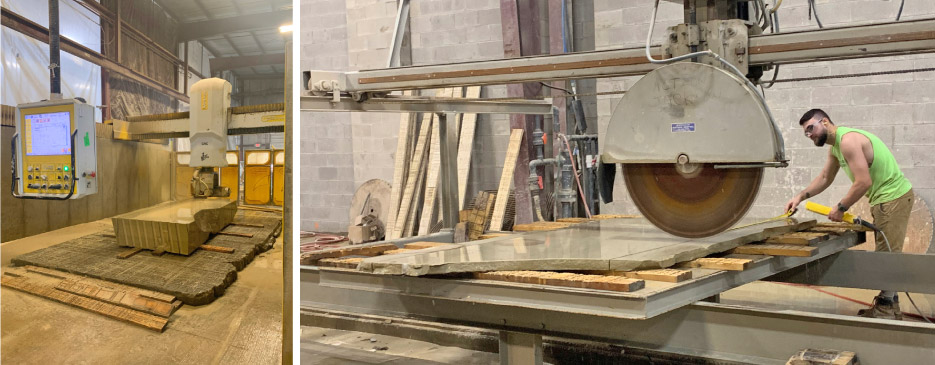 |
|
The Cleveland craftsmen are masters at carving replacements for worn stone. |
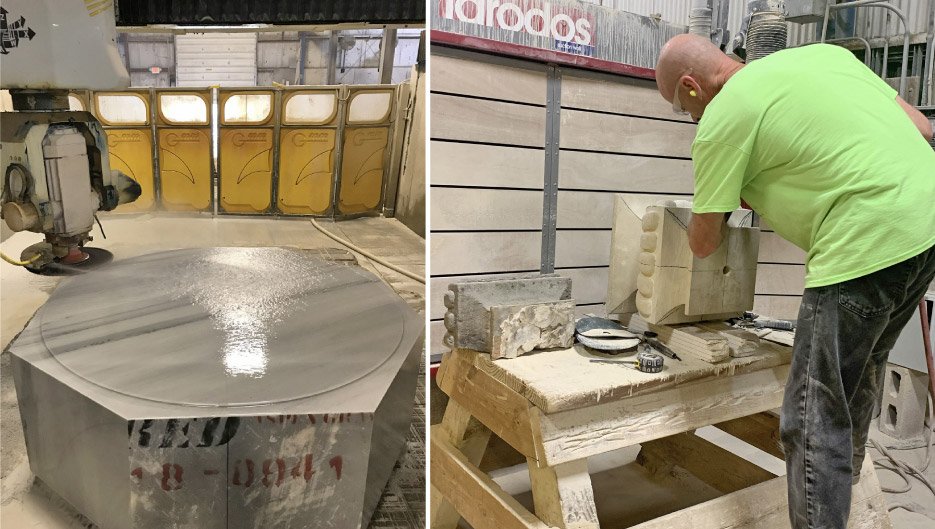 |
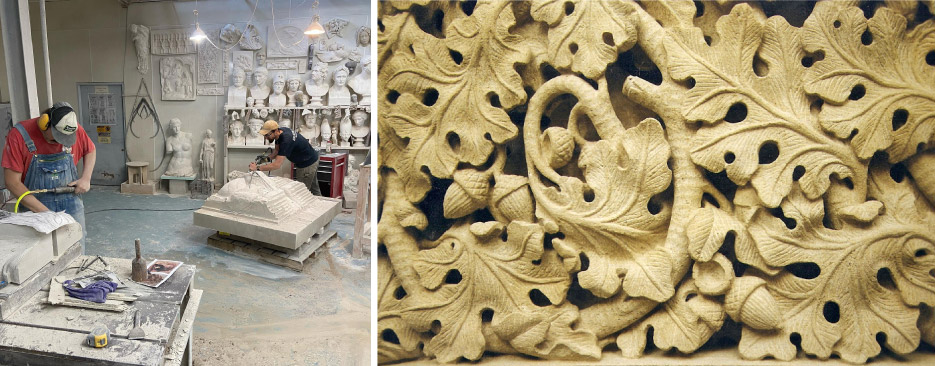
A ‘High Skill Set’
High-end work rests on the shoulders of a high-end workforce. Cleveland Quarries employs seven carvers, who have “a very high skill set” says Dunn.
“Our lead carver, I think he’s got at least 25 years of doing this,” says Carpenter, adding that old-world skills are passed on within the company. “It happens somewhat naturally, believe it or not. It’s not a structured program. It’s sort of a natural process,” he says.
On the computerized side of things, Carpenter explains, “you could go to school to be a CNC programmer, but the machines in the stone industry are unique to the stone industry,” he says. “Stone is a totally different animal.”
The bottom line is that the skills of the trade are honed on the job, and a lot of education and training happens within the company.
“It’s not just about programming saws, but how do you handle it, how does it work, what does it look like, do you cut with the grain or against the grain – there’s a lot of intricacies,” says Carpenter. “This isn’t something you can go to school for.”
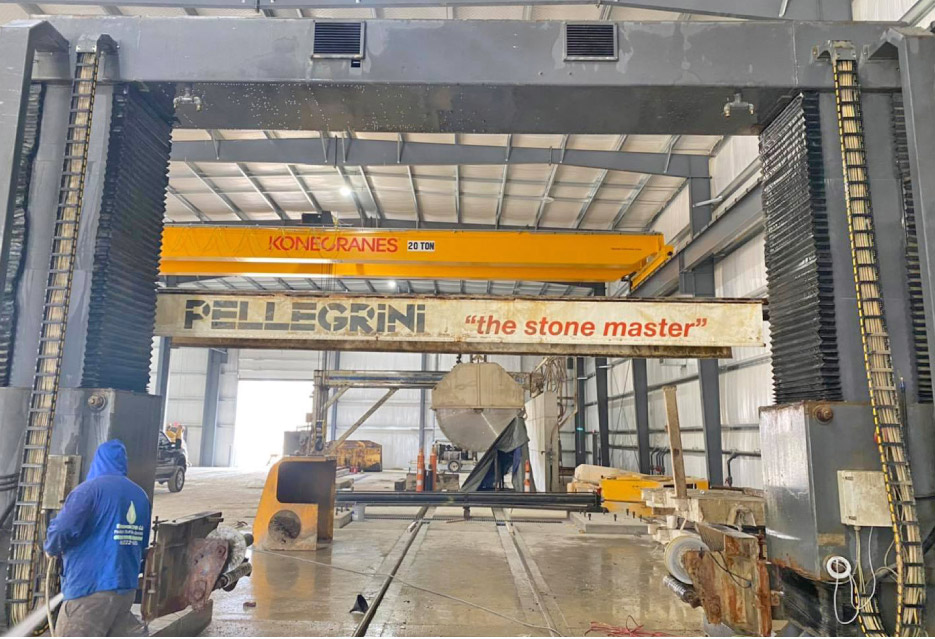 |
|
Above: Cleveland Quarries’ Pellegrini Block saw dimensions the big quarried boulders into square-dressed stone for futher processing. |
Carrying on a 175-Year-Old Legacy
Cleveland Quarries operates the only fully functioning quarry in the Berea sandstone; thus the company has inherited the legacy of all the buildings made from the stone.
“There are federal buildings and courthouses and cathedrals all over the country built out of this stone,” Dunn says. Because of that, there’s a steady flow of projects to repair, restore, or expand historical buildings.
The Michigan state capitol is one such project, completed in 1879 and clad “entirely out of our sandstone,” says Dunn. Some of the original hand carved elements of the building’s stonework were replaced with newly carved versions in 2015, and a new visitor center will be built with the same stone that was used on the building in 142 years ago.
The list goes on: “We’re doing a city park project down in the southern tip of Florida,” says Dunn. “We’ve got a couple restoration projects going on in the New York area. We’re doing some work out on Long Island– private residential projects. We’ve got a very large-scale project taking shape in Wyoming. We’re continuously doing work on the Canadian parliamentary complex in Ottawa.”
The scope of projects shows both the historical importance and the modern utility of Cleveland Quarries’ stone.
“That’ll give you a sense of how far spread out we are,” says Dunn. “The farther outside of Cleveland we get, the more unique things typically become.”
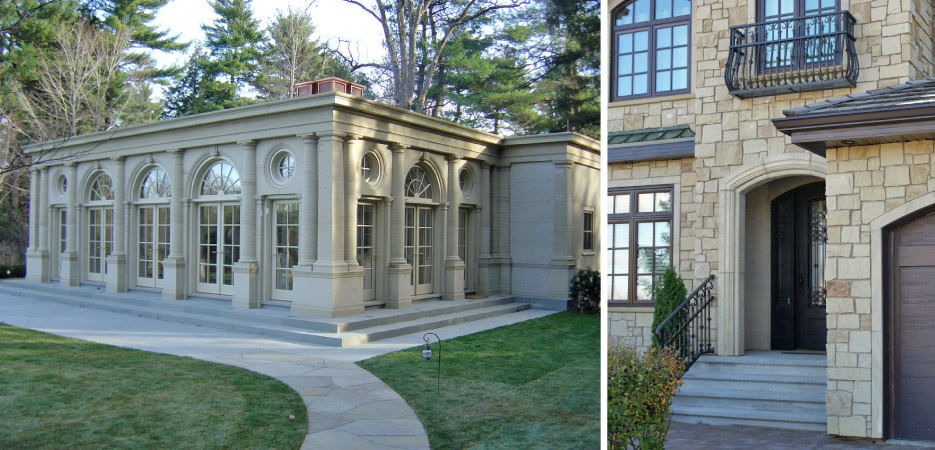 |
|
Above: Two iconic private residences showcase the different faces of this versatile limestone: Birmingham Buff dimensional sandstone and flagstone walkway, and Birmingham Buff veneer and cut stone façade.
|
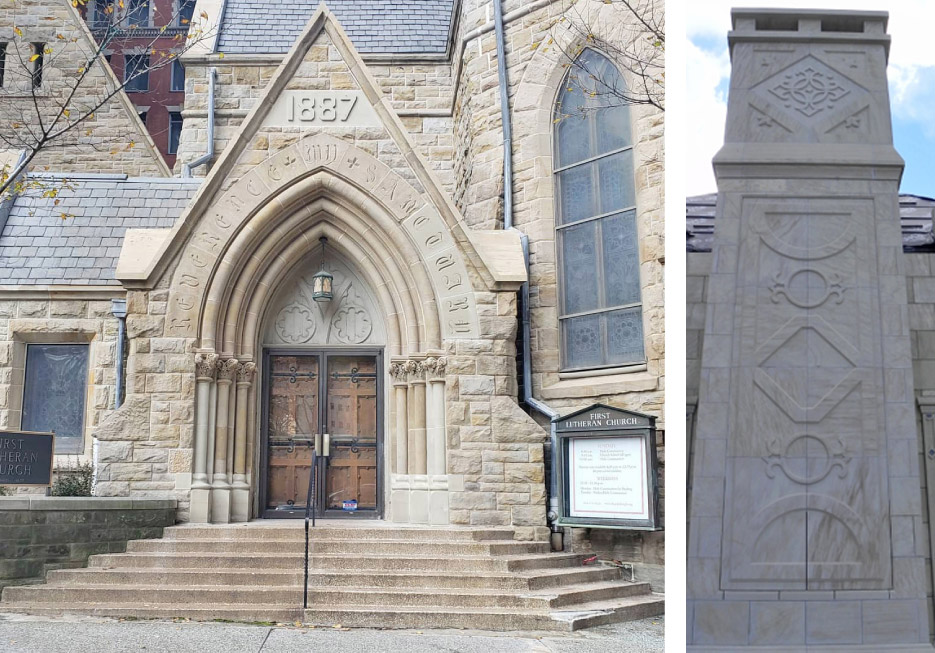 |
A Geologic Mystery
The Berea sandstone is a familiar stone amongst masons and architects, but to this day it remains a bit of an enigma in the geological community. The age of the rock has been hotly debated by geologists over the past 30 years. Depending on exactly who you ask, the Berea Sandstone is from either the late Devonian Period, or the early Mississippian Period. The dividing line between those two epochs of geologic time was 359 million years ago.
The problem stems from the fact that there are few fossils in the sandstone, and fossils are what’s commonly used to establish the age of sedimentary rocks. In the absence of fossil evidence, geologists are left with more subtle clues about the age, such as how the rock relates to the layers above and below it. The Berea sandstone spans several states and at present, the geological surveys in different states have assigned slightly different ages to the stone.
It’s always gratifying to watch the march of science as fuzzy questions become increasingly clear with better techniques and new analysis. But for now, we’ll have to be content to call the age of the Berea sandstone as somewhere around 360 million years ago, give or take a few million years.
Rewinding back to that part of geologic time, rivers were cutting deep channels down into the shale layers that sit below the Berea. Over time, the channels were filled with fresh sand that was carried in by the rivers. Sediments from river deltas piled more sand on top of the channels, creating a more or less level plain. Then sea level began to rise, washing in marine sand, like you’d find in a shallow beach. Each of these three phases laid down slightly different layers of sand, and by studying the patterns and ripples in the sediment, geologists can tell if the sand was left by a river, a delta, or an ocean.
Eons after the sand grains came to rest in a watery current, a mason’s chisel methodically, expertly, uncovers them. With the swipe of a blade, daylight spills across the sand, once again.
Karin Kirk is a geologist and science educator with over 20 years of experience and brings a different perspective to the stone industry. Karin is a regular contributor to usenaturalstone.com and the Slippery Rock Gazette. Contact her at karinkirk@gmail.com .
Note: This article is part of a series about American quarries. If you work for a quarry that’s a member of the Natural Stone Institute and you’d like your quarry to be featured here, contact Karin Kirk. Thank you!